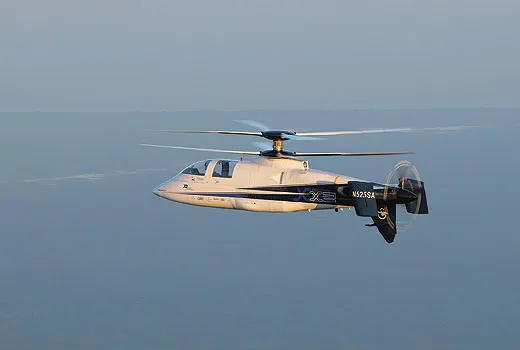From Zero to 250
Sikorsky’s X2 is more hot rod than helicopter.
/https://tf-cmsv2-smithsonianmag-media.s3.amazonaws.com/filer/JJ11-moments-and-milestones-FLASH.jpg)
The awarding of the 2010 Collier Trophy to Sikorsky Aircraft Corporation for its X2 helicopter marks the 100th anniversary of the nation’s premier aerospace prize. Every year, the National Aeronautic Association awards the Collier for “the greatest achievement in aeronautics or astronautics in America, with respect to improving the performance, efficiency, and safety of air or space vehicles, the value of which has been thoroughly demonstrated by actual use during the preceding year.” The X2 met that final requirement—“actual use”—last September 15, when it hit 250 knots (288 mph) in level flight with pilot Kevin Bredenbeck at the controls. Though that mark is an unofficial record, it’s a trophy-worthy speed.
Helicopters have a hard time flying very fast because their rotor blades have to cope with a phenomenon called “retreating blade stall.” When a helicopter is moving forward, there is no problem with the advancing rotor blades on one side of the rotor disk, as the airflow over them increases. But on the other side, the retreating blades experience diminished airflow as the helicopter continues to accelerate, and eventually the relative wind over the blades drops below the blades’ stall speed and they stop producing lift. When that happens, the helicopter rolls off to the retreating blade side and the pilot can no longer control it.
Sikorsky’s X2 is a compound helicopter (see “Hot Rod Helicopters,” Sept. 2009). That means that in addition to the main rotor, it has a dedicated thrust producer. Most previous compound helicopters have a tail-rotor that counters the twisting force of the engine and main rotor. But Sikorsky built a compound helicopter with a coaxial main rotor system: two four-blade rotors, set one atop the other and rotating in opposite directions so there are advancing blades on both sides, not just one. The counter-rotating blades cancel each other’s torque, so the X2 needs no tail rotor. Instead, on its tail is a propulsor—a six-blade propeller that produces forward thrust the way an airplane’s propeller does. As the helicopter speeds up, more of the LHTEC T800 engine power goes to the propulsor, and the main rotors can be slowed so the advancing blades’ tips don’t go supersonic.
The X2 is not Sikorsky’s first coaxial-rotor compound helicopter. The company designed, built, and tested the S-69 Advancing Blade Concept prototype, which was designated the XH-59 by the military. For forward thrust, it used a small jet engine instead of a propeller. Its 1970s technology was not as sophisticated as the X2’s, however, and it suffered from vibration problems.
The company launched the X2 program in 2005 and built the aircraft at Schweizer, its newly acquired subsidiary in Horseheads, New York. The X2’s first flight, on August 27, 2008, was just a short 30-minute hop to check out its hover characteristics. On July 26, 2010, it beat the previous speed record: a Westland Lynx reaching 225 knots (259 mph). Now Sikorsky is building a prototype for a compact military recon helicopter it calls the S-97 Raider. Its previous effort, the RAH-66 Comanche, was canceled by the Army; it couldn’t hit 250 knots. Looks like it was worth the wait for the X2. The 2010 award is a great way for the Collier to celebrate its 100th birthday—with speed.
